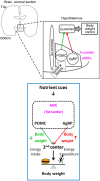Age-Associated Weight Gain, Leptin, and SIRT1: A Possible Role for Hypothalamic SIRT1 in the Prevention of Weight Gain and Aging through Modulation of Leptin Sensitivity
- PMID: 26236282
- PMCID: PMC4504171
- DOI: 10.3389/fendo.2015.00109
Age-Associated Weight Gain, Leptin, and SIRT1: A Possible Role for Hypothalamic SIRT1 in the Prevention of Weight Gain and Aging through Modulation of Leptin Sensitivity
Abstract
The hypothalamus is the principal regulator of body weight and energy balance. It modulates both energy intake and energy expenditure by sensing the energy status of the body through neural inputs from the periphery as well as direct humoral inputs. Leptin, an adipokine, is one of the humoral factors responsible for alerting the hypothalamus that enough energy is stored in the periphery. Plasma leptin levels are positively linked to adiposity; leptin suppress energy intake and stimulates energy expenditure. However, prolonged increases in plasma leptin levels due to obesity cause leptin resistance, affecting both leptin access to hypothalamic neurons and leptin signal transduction within hypothalamic neurons. Decreased sensing of peripheral energy status through leptin may lead to a positive energy balance and gradual gains in weight and adiposity, further worsening leptin resistance. Leptin resistance, increased adiposity, and weight gain are all associated with aging in both humans and animals. Central insulin resistance is associated with similar observations. Therefore, improving the action of humoral factors in the hypothalamus may prevent gradual weight gain, especially during middle age. SIRT1 is a NAD(+)-dependent protein deacetylase with numerous substrates, including histones, transcription factors, co-factors, and various enzymes. SIRT1 improves both leptin sensitivity and insulin sensitivity by decreasing the levels of several molecules that impair leptin and insulin signal transduction. SIRT1 and NAD(+) levels decrease with age in the hypothalamus; increased hypothalamic SIRT1 levels prevent age-associated weight gain and improve leptin sensitivity in mice. Therefore, preventing the age-dependent loss of SIRT1 function in the hypothalamus could improve the action of humoral factors in the hypothalamus as well as central regulation of energy balance.
Keywords: aging; energy homeostasis; energy sensing; inflammation; insulin resistance; leptin resistance; sirtuin; ubiquitin-proteasome system.
Figures






Similar articles
-
Hypothalamic SIRT1 prevents age-associated weight gain by improving leptin sensitivity in mice.Diabetologia. 2014 Apr;57(4):819-31. doi: 10.1007/s00125-013-3140-5. Epub 2013 Dec 29. Diabetologia. 2014. PMID: 24374551 Free PMC article.
-
Induction of hypothalamic Sirt1 leads to cessation of feeding via agouti-related peptide.Endocrinology. 2010 Jun;151(6):2556-66. doi: 10.1210/en.2009-1319. Epub 2010 Apr 7. Endocrinology. 2010. PMID: 20375183
-
[Obesity and the central regulation of energy metabolism].Nihon Rinsho. 2013 Feb;71(2):217-23. Nihon Rinsho. 2013. PMID: 23631196 Review. Japanese.
-
Brain somatic cross-talk: ghrelin, leptin and ultimate challengers of obesity.Nutr Neurosci. 2005 Feb;8(1):1-5. doi: 10.1080/10284150400027107. Nutr Neurosci. 2005. PMID: 15909762 Review.
-
Changes in the neuroendocrine control of energy homeostasis by adiposity signals during aging.Exp Gerontol. 2009 Jan-Feb;44(1-2):20-5. doi: 10.1016/j.exger.2008.05.005. Epub 2008 May 20. Exp Gerontol. 2009. PMID: 18572339 Review.
Cited by
-
Resveratrol Prevents Weight Gain, Counteracts Visceral Adipose Tissue Dysfunction, and Improves Hypothalamic Leptin Sensitivity in Diet-Induced Obese Rats.Mol Nutr Food Res. 2025 Aug;69(15):e70075. doi: 10.1002/mnfr.70075. Epub 2025 Apr 27. Mol Nutr Food Res. 2025. PMID: 40289401 Free PMC article.
-
A central-acting connexin inhibitor, INI-0602, prevents high-fat diet-induced feeding pattern disturbances and obesity in mice.Mol Brain. 2018 May 24;11(1):28. doi: 10.1186/s13041-018-0372-9. Mol Brain. 2018. PMID: 29793524 Free PMC article.
-
Adipose tissue macrophages in aging-associated adipose tissue function.J Physiol Sci. 2021 Dec 4;71(1):38. doi: 10.1186/s12576-021-00820-2. J Physiol Sci. 2021. PMID: 34863096 Free PMC article. Review.
-
Role for Leptin and Leptin Receptors in Stem Cells During Health and Diseases.Stem Cell Rev Rep. 2021 Apr;17(2):511-522. doi: 10.1007/s12015-021-10132-y. Epub 2021 Feb 17. Stem Cell Rev Rep. 2021. PMID: 33598894 Free PMC article. Review.
-
Fundamental role of pan-inflammation and oxidative-nitrosative pathways in neuropathogenesis of Alzheimer's disease in focal cerebral ischemic rats.Am J Neurodegener Dis. 2016 Jun 1;5(2):102-30. eCollection 2016. Am J Neurodegener Dis. 2016. PMID: 27335702 Free PMC article. Review.
References
-
- Organization WH. Obesity and Overweight (2015). Available from: http://www.who.int/mediacentre/factsheets/fs311/en/
-
- Lear SA, Humphries KH, Kohli S, Chockalingam A, Frohlich JJ, Birmingham CL. Visceral adipose tissue accumulation differs according to ethnic background: results of the Multicultural Community Health Assessment Trial (M-CHAT). Am J Clin Nutr (2007) 86(2):353–9. - PubMed
Publication types
LinkOut - more resources
Full Text Sources
Other Literature Sources

